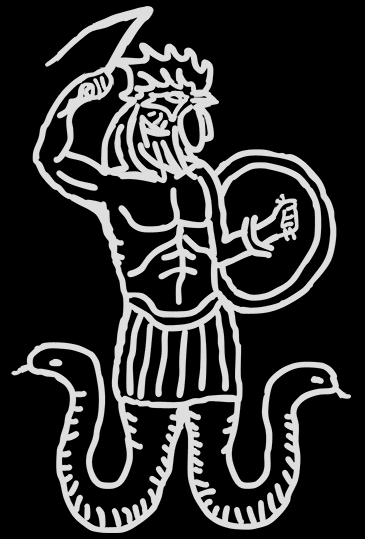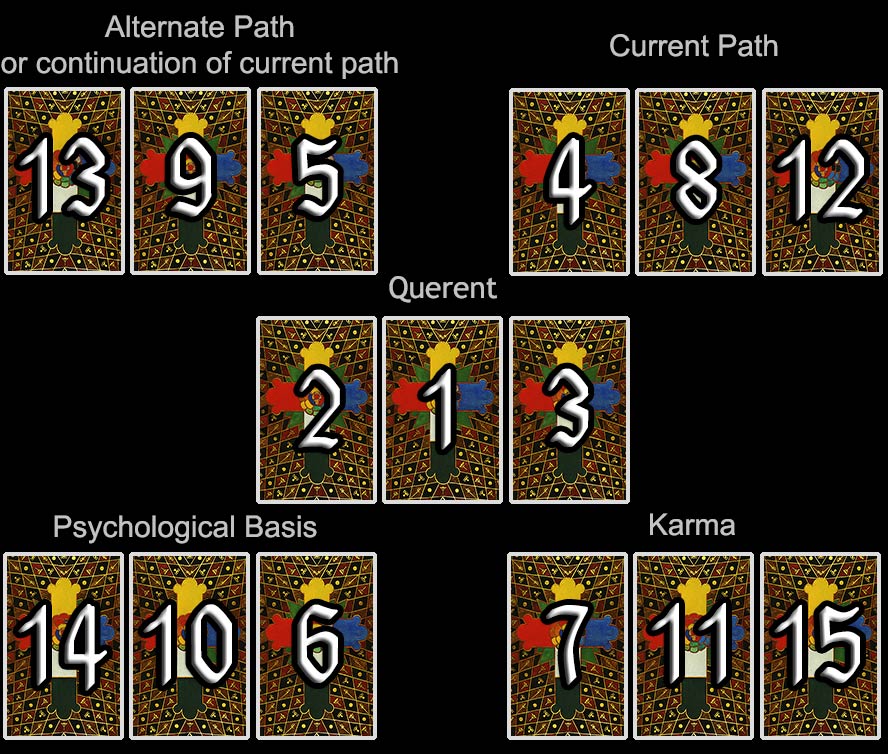Tarot spreads are an incredibly effective tool in unlocking hidden wisdom and understanding unconscious processes within ourselves. Using a spread, the cards paint a story that can provide insight into our lives and helps us answer pressing questions. Of course, the way we approach a reading can greatly affect the outcome.
Begin the exercise of reading your cards in a relaxed and receptive state of mind. It’s best to avoid an analytical mindset and instead open ourselves to spiritual messages that may come in irrational forms. This is why meditation or ritual can be helpful in achieving the right state of mind for tarot.
Tarot spreads can be used to reveal hidden factors about a situation. They can be tailored to specific questions or decisions. The symbolism in each card holds spiritual significance that, by reading the context of the other cards, can speak to you on a deep level.
The following list of tarot spreads is a GPS for those looking to explore the universal consciousness. These layouts were developed by different experts over time and deliver accurate, pragmatic readings. While the descriptions below were written for tarot spreads, they can also be used for other oracle layouts.
Definition
A tarot spread is a template that a reader uses to arrange the cards. Each tarot card is interpreted normally plus by its layout position, including the way the influence of this card may bleed into the meaning of each card adjacent to it.
Elemental Dignity vs Reversals
With tarot decks on this site that do not use reversals, the traditional occult method of determining elemental dignities can be used to determine whether each card is well-dignified or ill-dignified. The dignity of each tarot card is based on how the adjacent cards relate to it. Each tarot card is interpreted one at a time to determine its dignity, meaning how it is affected by its neighbours. Adjacent cards of the same suit strengthen a card’s dignity, providing a sort of power boost to the card’s appeal. Tarot cards of directly opposite suits reverse each other’s positive charge, causing ill-dignification. For example, if a cups card had a wands card next to it, this would rub the cups card the wrong way and cause it to become ill-dignified. (Wands are the opposite of cups, and swords are the opposite of pentacles.) Cards that are not of the opposite or the same suit are considered neutral and have no effect (such as a wand next to a sword or a sword next to a cup). Major Arcana can sometimes be disregarded as they don’t always correspond to a particular element (fire, water, air, earth) as Minor Arcana cards do. The Golden Dawn method is the tarot spread that relies most heavily on elemental dignities.
Since Rider-Waite-inspired decks generally use reversals, this makes it easy to interpret each card’s dignity, which is not affected by adjacent cards but by its own orientation, as in facing up or down. Traditionally, reversed card meanings were not used much in tarot spreads until after the ground-breaking Rider-Waite deck incorporated them. Reversals were introduced by Etteilla, who published the first material on cartomancy reversals in 1770 using a deck of 32 cards (perhaps influencing Madam Lenormand). Reversals are not an option with several decks simply because the artist did not intend for their creation to be read with reversals, and that being the case, they did not write reversed meanings.
On the other hand, one may decide to disregard the elemental dignities if they are too much trouble. Of course, it is best to interpret the cards according to one’s personal perspective, gaining understanding through one’s own methods of learning. Suggestions on how to read tarot cards using elemental dignities and such as presented on this site should serve merely as a guideline, not as a rule. Each reader should come to understand tarot reading through diligent practice, weighing the interpretations by their own standards.
(adsbygoogle = window.adsbygoogle || []).push({});
Simple Tarot Spreads
One-Card Tarot Reading
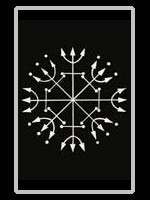
Difficulty: Easiest
A quick one-card reading for concise insight or daily focus. Used for general guidance, meditation, or direct questions. It can be used for just about any question, including drawing a card of the day, week, or even one’s card of ultimate destiny. It can also be used repetitively as in a serial format, since some readers prefer to pull one card at a time, watching as a story unfolds.
Three-Card Tarot Spread
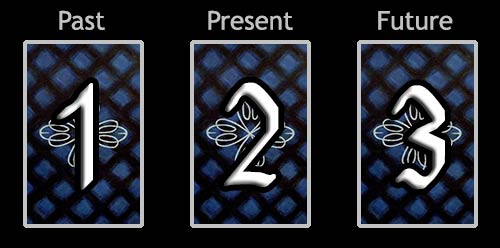
Difficulty: Very easy
This three-card layout can be used to shed light on the influences that have passed, current influences, and what is approaching in the near future. Little explanation is necessary for such a simple tarot spread. Use this spread for Past/Present/Future readings or any other trinity you like.
The Blind Spot
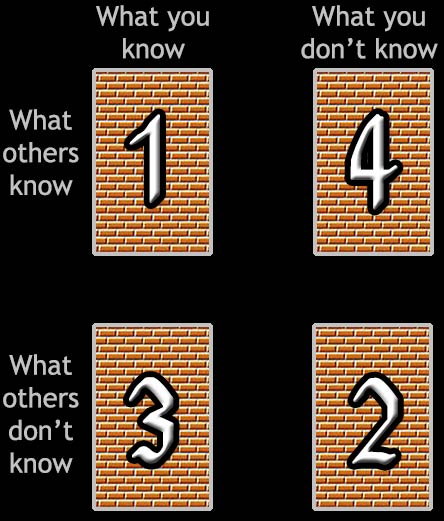
Difficulty: Varies
This tarot spread is used to enhance self-awareness. Questions about learning something about oneself or things that are hidden work very well with this tarot spread, although no question is necessary.
- This tarot card displays the obvious identity, the part of oneself that is consciously known and projected to others.
- This card indicates unconscious driving forces that neither the reader nor others are aware of about them, the great unknown. Nobody knows what this tarot card means, at least not yet…
- The part of oneself that is concealed, to keep others from discovering, is apparent in this card.
- This is the Blind Spot. This is what was asked about, that which this reading should bring awareness of. The reader may wish to pay close attention to these mannerisms.
The Cross Tarot Spread

Difficulty: Easy
The Cross Spread is good for questions and advice. It can also be used to determine the meaning of a confusing card from a previous reading, or for that matter, to shed light on other points of confusion.
In questions asking advice, this tarot spread is self-explanatory. The main thing is to determine the difference between cards #2 and #3. #1 is the topic and #4 is the result.
In questions regarding confusion, such as: “What was the meaning of Card (X) in the last spread?” the main thing is also to determine the difference between cards #2 and #3. In this case, #2 will show what the card was not referring to, and Card #3 will show what was really meant. Card #1 is the topic and #4 represents the purpose it serves.
The Horse Shoe Tarot Spread
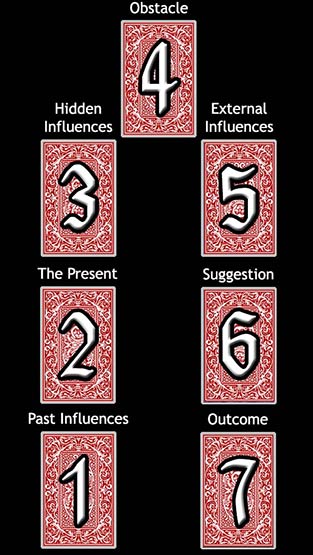
Difficulty: Easy
The Horse Shoe is more advanced than the three-card reading, yet simpler than most other spreads. It is a versatile method that can be used for most queries, though there are other spreads that would go into more depth. As the simple Past, Present, and Future spread, it contains these cards in positions #1, #2, and #7, but also has four other tarot cards that help the reader understand how to deal with the future better. The cards are to be read as follows:
- The Past: Past events affecting the question.
- The Present: The current state or approaching influence.
- Hidden Influences: Things the reader may not be aware of (or barely be aware of).
- Obstacles: This is the challenge: obstacles may be avoided or may have to be dealt with.
- External Influences: Attitudes and thoughts regarding people around the reader.
- Suggestions: Recommended course of action.
- Outcome: The result of following the suggestions.
(adsbygoogle = window.adsbygoogle || []).push({});
The Ankh Tarot Spread
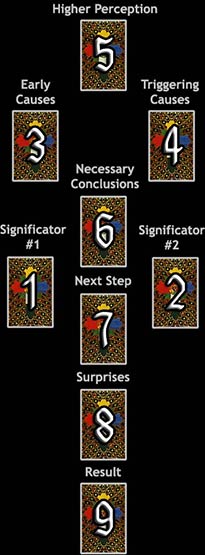
Difficulty: Kind of tough
The Ankh Spread is for questions about the causes behind trends. It is similar to the Celtic Cross and Secret of the High Priestess spreads, but it covers the reasons behind the circumstances in question differently, perhaps giving a better explanation of why things are the way they are.
The loop of the upper section of the ankh reveals the spiritual background and causes of the situation, while the stem of the base focuses on prospects for the outcome.
The first two tarot cards represent the two parent causes of the situation. They will either complement each other or show two opposing sides of a conflict, depending on how they relate. These are the significator cards of the Ankh spread.
3. This tarot card shines light upon the early causes of the trend in question.
4. Pinpoints the causes that triggered the current situation.
5. Reveals the spiritual perspective of the subject at hand.
6. This card examines the reasons why this course of action had to unfold, as a means to this end.
At this point, it is good to pause to soak in the meaning of the first six cards before moving forward to the last three cards. The last three reveal prospects for the future.
7. The Next Step gives clues about the immediate future.
8. Surprising Experiences encountered en route to the result.
9. This represents the result.
The Celtic Cross

Difficulty: Average
This is probably the most well-known tarot spread, the perfect match for the Rider-Waite. A good, basic spread for beginners to practise with, the Celtic Cross is useful for questions of all types. In this spread, it can be helpful to notice the relationships between the pairings of cards #5 & #9, #1 & #2, #3 & #4, and #6 & #10.
- The significator epitomises what the reading deals with, the initial situation.
- An added impulse that compounds the significator, which may be either complementary or contradictory.
- This is what is consciously known (thoughts).
- Unconscious driving forces that may not be known fully (emotions).
- The immediate past regarding the current situation.
- The first future card indicates the immediate future.
- This card represents the reader and their attitude towards cards #1 and #2.
- The external influences, the places, and people that influence the topic.
- This tarot card suggests expectations; what is secretly hoped for or feared.
- The second future card reveals the long-term outcome.
The Secret of the High Priestess
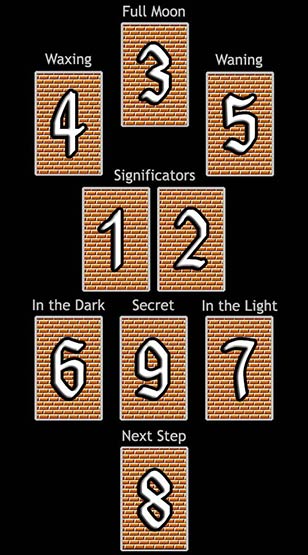
Difficulty: Average
This spread makes a nice alternative to the Celtic Cross, which covers basically the same ground. It is useful when a question doesn’t quite call for the Ankh spread. This tarot spread is helpful for looking into a current trend. The High Priestess may or may not present a mysterious secret to be analysed after the rest of the spread.
1. & 2. Main impulses that represent the topic at hand. They may complement or oppose one another.
3. This is the current influence at this time.
5. The Waning Moon is the influence that is moving into the past.
4. The Waxing Moon indicates what is on the horizon, or the approaching influence. This is the immediate future.
7. The Light is what is clearly recognised, consciously.
6. The Dark indicates what is there but not fully perceived, though noticed on a deeper level of consciousness.
8. The Next Step is the near future, where this journey leads.
9. The final tarot card, only if it happens to be of the Major Arcana, reveals the Secret of the High Priestess. This is a special message that should be given added weight.
Comic Strip Spread
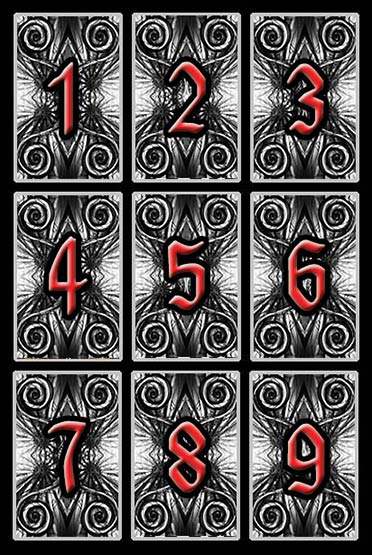
Difficulty: Easy
Note: This spread works best with decks like the Diary of a Broken Soul or Surrealist Tarot because they display scenes rather than pips and do not use reversals.
The Comic Strip Tarot Spread is a simple nine-card chronological pattern that looks like a page of a comic book. This method should be used to get a glimpse of the future as it would pan out naturally. It may be insightful to use this spread in coordination with biorhythms. The spread is easy to read as a storyboard, just like a comic strip.
The main subject is apparent in the first card, while the story plays out through the following tarot cards.
It is important to pay particular attention to the cards and the relationships with their neighbours. Notice which directions the characters on the cards are facing, and how they interact.
(adsbygoogle = window.adsbygoogle || []).push({});
Relationship Spread #1
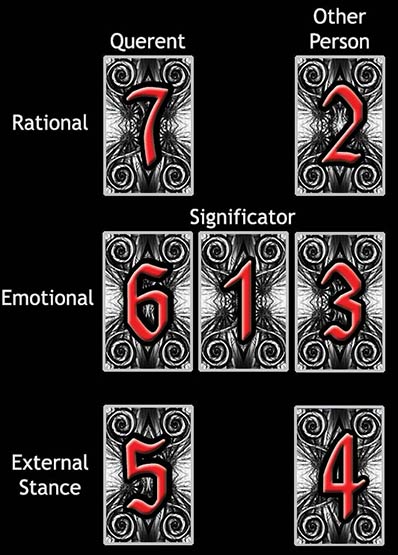
Difficulty: Easy
This convenient tarot spread is like an easy-to-read chart. In this layout, court cards generally indicate actual people with the same characteristics. Knights (or corresponding princes, but not kings) and queens are meant to represent actual men and women in this tarot spread. Look for patterns in the cards as always.
Card #1 is the overall significator of the relationship. The two columns on either side of the significator characterise each individual’s role in the relationship. The relationship does not have to be romantic. In fact, it could be a relationship between a person and a group, or even how two groups relate.
The top row, cards #7 & #2, is about the conscious thoughts of each person, or what they think about the relationship and likewise how they view their partner.
The middle row, cards #6 & #3, reveals the way each individual feels about the other. Emotional awareness corresponds to a person’s unconscious thoughts that run deep, affecting a person in ways he or she is not fully aware of.
The bottom row, cards #5 & #4, represents the way each person behaves, in other words, the stance taken regarding the relationship. The way a person acts may be genuine, but sometimes people are phoney and manipulative, so it is best to weigh this card against the other person’s cards to determine how they match up.
Relationship Spread #2
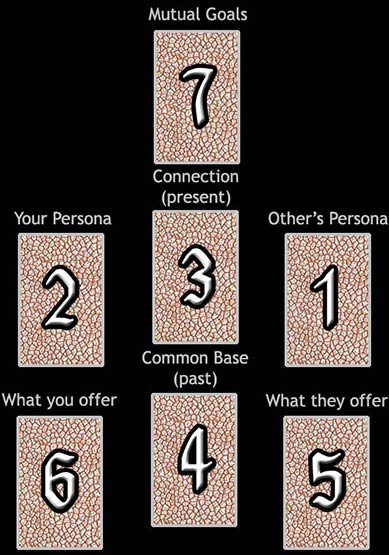
Difficulty: Easy
This relationship spread focuses more on the common ground of the relationship, with three cards in the middle column showing the common ground. The middle column essentially displays the past, present, and future of the relationship.
Card #4 stands for the common base of the relationship, which may be thought of as the past events which have shaped their characters, bringing them together. The current connection that binds them together is Card #3, indicating the values shared. Card #7 implies the common goals that would keep the pair together moving into the future.
The columns on either side show what each partner brings to the table. Remember, relationships need not be romantic, and the partners could even be groups rather than individuals. In this layout, the other person is on the left-hand side and the reader on the right.
Cards #1 & #2 indicate the separate personalities of each member of the relationship. These cards form a sort of bridge with the cards beneath them, #5 & #6, which show the qualities that each partner offers the other person, and thus to the relationship as a whole.
Advanced Tarot Spreads
The Love Triangle
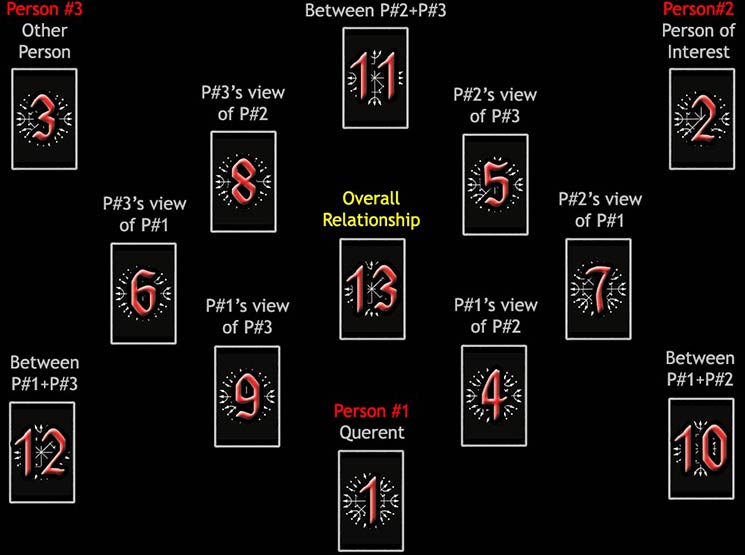
Difficulty: Complicated
The Love Triangle tarot spread can be used to determine the dynamics of the relationship between three people, regardless of whether romance is involved. It is arranged in the form of a hexagram, consisting of several large and small triangles. This spread may seem somewhat complicated, but it is not entirely that difficult.
The first step is to interpret the card for each individual position in the spread. Generally, one might ask about a relationship they are involved in, but this does not have to be the case. Ordinarily, the reader’s representative card is #1, their main person of interest is #2, and the other person would be #3.
The second step fills in the downward triangle and involves a further examination of the individuals through their views of other people. Each person has two more cards showing the way they see and relate to the other members of the triangle. For example, Card #6 indicates how Person #3 relates to Person #1, while Card #9 stands for Person #1‘s attitude towards Person #3.
The next step completes the upward triangle and the hexagram, focusing on cards #10–13. It also completes the many smaller triangles and hints at the potential for each relationship. The final card, #13 can be considered the significator of the reading, which suggests the overall potential for this three-way relationship.
The Decision

Difficulty: Easy
This simple but highly useful tarot spread calls for a question to be asked in this format:
“What happens if I do (X), and what happens if I do not do (X)?“
Please note that it should not be viewed as a decision between two different options, but about whether a single option should be exercised or not. A second option would call for a separate reading.
Card #7 is the significator, the overall theme of the query.
Cards #3, #1, & #5 represent the chronological sequence of events that occurs if the reader chooses to do (X).
Cards #4, #2, & #6 represent the chronological sequence of events that unfolds if the reader chooses not to do (X).
The Path Tarot Spread
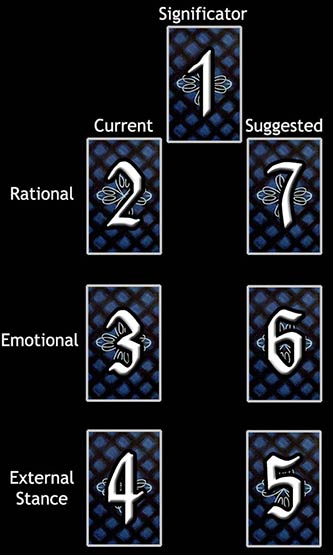
Difficulty: Easy
For the Path reading, one asks for suggestions on how to behave properly to achieve the desired result. The Current column represents how the reader has been acting, and the Suggested column suggests how they should act to achieve a certain goal. The chart-like spread uses the standard three levels: Rational, Emotional, and External Stance (how one projects oneself outwardly). When comparing the Current and Suggested cards, the most important thing is to notice the differences between the two cards. It is these differences that hint at the behaviours that should be altered.
Card #1 is the significator, the card which should reflect the nature of the query and/or the desired outcome.
Card #2 shows the way the reader is and has been thinking. Card #7 suggests how to change the way one thinks to serve themselves better.
Card #3 suggests the reader’s emotional attitude. Though it may seem difficult to manipulate one’s own emotions, it can be done if one puts their mind to it. For example, acting a certain way such as smiling intently for a few minutes will lead emotions to follow. When a person tries this, as silly as the exercise seems, they find this to evoke the emotion of happiness. For this reading, one should try to make themselves feel the way that Card #6 proposes.
External Stance means how one acts outwardly and how they hope others see them. Card #4 is about how the reader has been acting, while #5 indicates how they should act outwardly, for other people’s sake. It is the differences between these cards that hint at what behaviour patterns should be altered.
The Game Plan
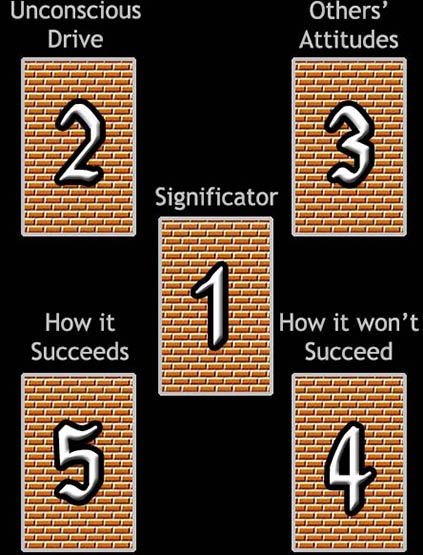
Difficulty: Easy
When a person has a certain plan in mind, this simple five-card spread presents a choice, hinting at what action or attitude should be taken for their plan to succeed, and what should be avoided to help the plan work out for the best.
The initial card is laid in the centre of the layout, the significator. The following four cards are laid out clockwise around the significator.
In this spread, the second card is about what drives the reader, but also says they are not fully conscious of this, perhaps even completely unaware of it. It provides a hint as to the reason they strive for their goal.
The third card uncovers what others think of the reader and their goals. The reader may or may not be aware of this. Sometimes other people factor into the plans (and sometimes they don’t).
The fourth card suggests what not to do. If things are permitted to go down this path, the plan will collapse.
The fifth card is a hint as to how to make this plan work out favourably. The idea this card presents should be followed to make the plan successful. The differences between Cards #4 & #5 should be noted, as the differences provide important clues.
(adsbygoogle = window.adsbygoogle || []).push({});
The Astrological Tarot Spread
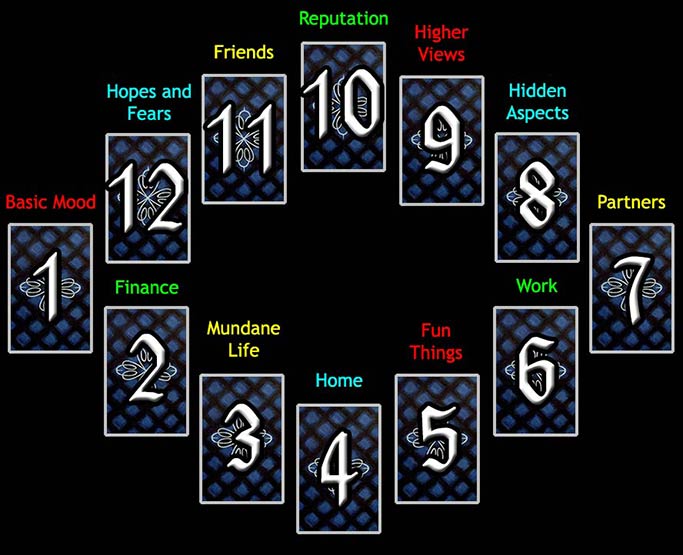
Difficulty: Complicated
The Astrological Tarot Spread is based on houses of astrology. This complicated spread takes several steps to understand.
The first step is to interpret the tarot card for each individual position in the spread.
The second step involves a further examination of the main axes. Positions 1 & 7 show the relationship theme, #1 representing the reader, #7 their partner. Positions 4 & 10 indicate motion. #4 indicates where the reader is now, and #10 suggests what they are moving towards.
The third step involves breaking down the chart into triads according to their house elements.
Positions 1, 5, & 9 represent the Fire triad, symbolising temperament and personal development.
Positions 2, 6, & 10 represent the Earth triad, concerned with materialism, money, and work.
Positions 3, 7, & 11 represent the Air triad, which has to do with thoughts, ideas, and connections with other people.
Positions 4, 8, & 12 represent the Water triad, the realm of emotions, moods, intuition, and yearnings.
Further, other patterns and correlations between certain numbers can be noted. Certain numbers such as the set of 5, 7, & 8 often speak about a particular theme.
The Three Pyramids (or Self-Actualisation Pyramids) Tarot Spread
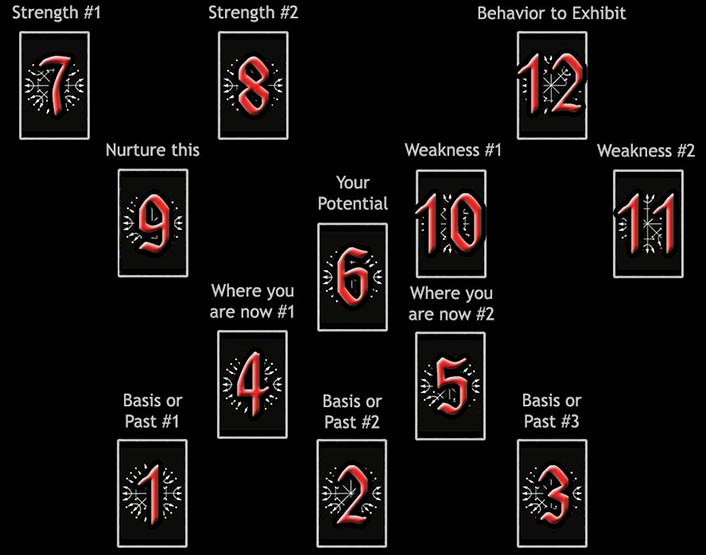
Difficulty: Complicated
Basically, there is the main pyramid in the centre, and two smaller pyramids on each side. One is inverted.
Positions 1 & 3 represent where the reader comes from, or what has made them/shaped them on various levels. Can be from environment, upbringing, schooling, etc. A look at the past, but with more objectivity than is usually given when using tarot cards.
Positions 4 & 5 represent who the reader is right now. It May or may not make pleasant reading, but hey, this is what this is about, right?
Position 6 represents who the reader could be. Again, it might or might not look good, but a person can learn from that and change who they are accordingly. (This is a bit like how Scrooge did things in ‘A Christmas Carol’.)
Positions 7 & 8 are the reader’s strengths. This is the light they have, which can be bought to the forefront. What carries the person should not be hidden or unacknowledged.
Position 9 represents what should be given to oneself or created within.
Positions 10 & 11 represent personal areas for development or weaknesses. Again, might not make good reading, but if someone looks at their strengths first, they will be able to see a balance is there and can choose to focus on one side or the other. This is where a person could really see how their shadow side comes into play.
Position 12 represents what the reader should be offering externally, or what they can bring to their world or to others who inhabit that world.
The Golden Dawn Spread
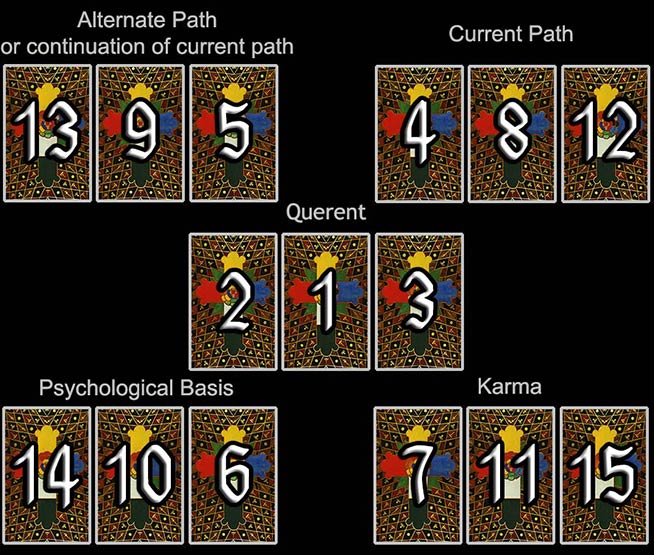
Difficulty: Complicated
Note: Tarot decks that use reversed cards such as the Rider-Waite do not work well with this spread, which was designed to be read using elemental dignity.
The Golden Dawn tarot spread is best suited for use with the bifrost Tarot and especially the Book of Thoth, as these decks are meant to be read a certain way with the court cards. Princes and queens represent actual men and women connected with the matter, while princesses generally represent ideas, thoughts, or opinions, and knights represent the arrival or departure of a matter depending on the direction faced.
In this tarot spread, particular attention should be paid to a card’s position in relation to its neighbours. Whether the neighbour cards bear the same energy (same suit) determines whether a card is considered well-dignified or ill-dignified. Opposite suits ill-dignify each other, while other suits are considered friendly. Tarot cards of the same suit or element strengthen each other.
As with other tarot spreads, it is important to count the cards’ tendencies, such as whether there is a lot of one particular suit or number pattern. The patterns reveal special messages. Having several majors present indicates higher forces at work, several cups suggest strong emotions, etc.
Card #1 represents the reader and the nature of the topic at hand.
Cards #2 & #3 are read as an extension of #1 to further comprehend the nature of the topic.
The two sets of three tarot cards at the top of the spread represent chronological sets of events. The current path as it would unfold naturally is represented by cards #4, #8, & #12. The alternate path that could be taken is represented by cards #13, #9, & #5. However, if the reader gets the feeling these cards are telling them they go together, then the alternate path is to be considered an extension of the current path, and to be read chronologically in this order: #4, #8, #12, #13, #9, #5. Just keep in mind: this is only if the two paths seem particularly similar.
Cards #14, #10, & #6 shed light upon the psychological undertones of the current issue.
Cards #7, #11, & #15 represent the influences of karma and destiny beyond the reader’s control. These cards suggest adapting to this, as fate.
Highly Advanced Tarot Spreads
The Opening of the Key: Instructions for the First Operation
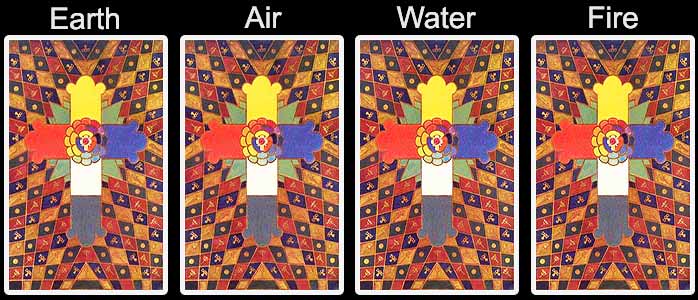
The Opening of the Key (OOTK) is a profound Golden Dawn tarot reading method that unveils the intricate correspondences between the cards, the elements, and the querent’s life path. This method systematically reveals hidden patterns, drawing from the deck’s alchemical structure. The First Operation focuses on the four classical elements—Fire, Water, Air, and Earth—serving as the foundational layer of inquiry.
Preparation and Sequence
Follow these steps with intention, allowing the deck to guide the revelation:
- Shuffle and Divide the Deck Shuffle thoroughly while focusing on the querent’s question. Divide the deck into four equal piles, each aligned with an element:
- Fire: Wands (vitality, inspiration, action)
- Water: Cups (emotion, intuition, relationships)
- Air: Swords (intellect, conflict, clarity)
- Earth: Disks (materiality, stability, manifestation)
- Select the Significator Choose a card representing the querent, typically a Court card corresponding to their Sun sign or selected intuitively. Place it face down within one of the four piles, keeping its location private.
- Identify the Active Pile Select the pile containing the Significator (intuitively or through a brief cut). Set the other three piles aside. This chosen element illuminates the dominant force in the querent’s current destiny.
- Count from the Significator Locate the Significator within the pile. The direction the figure on the card faces decides the direction of the count: right (forward, towards the future) or left (backward, towards the past).
Proceed by the card’s numerical value:- Aces: 11
- 2–10: Face value
- Princess: 7
- Prince, Queen, Knight: 4 each
- Trumps: 3 (elemental), 9 (planetary), 12 (zodiacal)
- Reveal the Seven Cards The Significator plus the six cards uncovered through counting form the ‘opened key’. Lay them out in the order of discovery. These cards delineate the querent’s present circumstances, influencing forces, and emerging trajectory.
Interpret the Pattern Analyse the cards through:- Dignities: Elemental affinities (e.g., Fire supports Air but clashes with Water; Earth grounds but may restrict).
- Relations: Interactions between adjacent cards, revealing support, tension, or flow.
- Astrological Layers: Attributions to planets, signs, and paths for deeper nuance.
The selected pile sets the thematic tone, while the count’s direction emphasises inner reflection (backward) or external action (forward). Consider the discarded cards as echoes of untapped potentials, enriching the narrative of the final seven.
This operation invites a meditative dialogue with the deck, layer by layer. For advanced operations or variations, explore the full OOTK sequence in the Thoth tradition. May it illuminate your path with clarity and insight.
Waite’s Full-Deck Reading Method
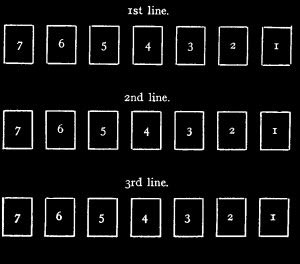
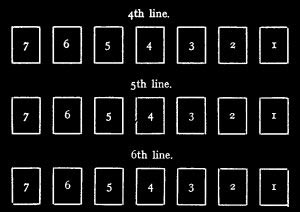
This two-part system derives from the extended method outlined by Arthur Edward Waite in The Pictorial Key to the Tarot (1910). Waite never named it, though its complexity rivals the Golden Dawn’s ‘Opening of the Key’. It is his complete ceremonial approach to divination using the entire 78-card deck, carried out in two successive operations.
On Tarotsmith, the procedure is automated for practical use while preserving every symbolic and ritual step that Waite intended. The software handles shuffling, cutting, dealing, reversals, and layout generation, freeing you to focus entirely on ceremony and interpretation.
The Spirit of the Full-Deck Method
Waite’s system treats the Tarot as a map of consciousness. Every card participates in a universal structure, so the whole deck must be mobilised for truth to emerge. The two operations—first external, then internal—correspond to two planes of reality: the visible and the invisible.
The first operation reveals what has already manifested: events, circumstances, and the apparent condition of the querent.
The second operation discloses the hidden machinery behind those events: causes, intentions, psychic currents, and destiny in motion.
Each phase has its own ritual logic and symbolic pattern. Together they form a spiral of understanding, beginning in the outer world and moving towards the secret centre.
Instructions
Step 1: Choosing the Significator
Before shuffling, determine the Significator: the card representing the querent.
Traditionally, Waite suggested The Magician for a male querent and The High Priestess for a female. These archetypes embody active and receptive consciousness, respectively.
The Significator is not drawn at random. It is assigned, marking the querent’s point of identification within the spread. On Tarotsmith, this step occurs automatically when you select gender.
Step 2: Shuffling and Cutting
Shuffle the full deck thoroughly, mixing the currents of consciousness.
Then cut the deck once with the left hand, symbolising surrender to unseen forces and awakening the right brain hemisphere. The left hand governs intuition and the receptive current of will.
On the site, this act is simulated—either at random or at a specific point chosen from 1–78.
This cut determines the order in which the universe will now reveal itself.
Step 3: Dealing into Packets (the 42 Cards)
The reader then deals 42 cards into six packets of seven.
This stage begins the first operation, which concerns the outer, manifest conditions surrounding the querent. The number 42 (6 × 7) reflects the structure of the cosmos in Hermetic numerology: six directions in space, seven stages of emanation.
Each packet may represent a particular sphere of life:
- The self and personal will
- Relationships and emotional ties
- Career and social expression
- The home and inner circle
- Hidden influences and karmic debts
- Forces soon to appear
In traditional practice, these packets are observed sequentially; their top cards can be read individually or in sequence as ‘narrative threads’. Tarotsmith displays the full packets for visual reference, preserving Waite’s original structure without manual sorting. You can check the packets layout to determine whether and where your significator appeared—representing the querent’s consciousness at the center of unfolding experience.
Step 4: Constructing the Six-by-Seven Grid
After the 42 cards are dealt, the same pattern is reorganised into a 6×7 grid, showing the dynamic web of the reading.
In Waite’s printed instructions, the exact visual geometry was partially shown; Tarotsmith renders the entire grid automatically above the packets when they are determined. You can now see at once what formerly required extensive manual arrangement.
Step 5: Reading the First Operation
This grid constitutes the First Operation.
Interpret it as a complete picture of the querent’s world as it presently stands.
Read horizontally, vertically, or diagonally as intuition leads. Note elemental clusters (Wands, Cups, Swords, Pentacles), repeating numbers, and major arcana concentrations.
The first operation concerns manifestation—what has already become visible. It is read before any attempt is made to proceed further. Skipping this phase defeats the entire logic of the spread. Only after absorbing the visible structure can the inner truth be pursued.
The Second Operation: Inner Revelation
When the first operation is complete, the second begins.
Where the first revealed the outer map of experience, the second traces the hidden currents beneath it—motives, spiritual causes, and the subtle motion of destiny.
At this stage, you set aside the first forty-two cards, keeping them together in a single heap with the Significator placed face-up on top. These cards form the established field of manifestation and are no longer handled.
You then take up the remaining thirty-five cards, which were not used in the first operation. These are shuffled and cut again in the same manner, opening a new cycle of revelation.
The thirty-five cards are now divided into six packets, distributed as follows:
- Packet I: 7 cards
- Packet II: 6 cards
- Packet III: 5 cards
- Packet IV: 4 cards
- Packet V: 2 cards
- Packet VI: 11 cards
These are then laid out to form six uneven lines, which Waite specified to be read as:
- The First Line: the house, environment, and external setting.
- The Second Line: the person or subject of the divination.
- The Third Line: what is passing outside; events and other influences.
- The Fourth Line: the unexpected; things arising without foresight.
- The Fifth Line: consolation; what mitigates or moderates the unfavorable.
- The Sixth Line: the elucidation; this line interprets the rest and has no independent meaning apart from them.
On Tarotsmith, these lines appear above from the first spread, allowing the entire work to be seen at once (except on mobile devices)—the visible world below, the invisible above.
This second operation completes the full-deck Waite method. It deepens and fulfils the first operation, providing the occult commentary behind the manifest story.
How Tarotsmith Simplifies the Work
Waite’s complete ritual requires multiple redistributions, cross-counting, and reassembly of cards—laborious even for trained initiates.
Tarotsmith’s digital edition preserves all the symbolic stages but automates:
- Shuffling, cutting, and reversals (with adjustable probability).
- Packet division and grid generation (both operations clearly shown).
- Sequential logic tracking, ensuring each stage is completed in order.
This allows you to experience Waite’s full-deck method as it was meant to be studied—without losing accuracy to fatigue or error. The software keeps perfect memory of the sequence while allowing you to read intuitively.
The Philosophy Behind the Spread
Waite’s aim was not prediction but illumination.
He regarded the Tarot as a symbolic engine for inner revelation. The first operation shows you the world you think you inhabit; the second uncovers the one your soul has actually constructed.
The querent thus witnesses the transition from phenomenon to noumenon, effect to cause, surface to spirit.
Each reading becomes an alchemical process: the deck dissolves the illusion of separation between the visible and invisible worlds.
Adapted from A. E. Waite, The Pictorial Key to the Tarot (1910).
Digitally adapted and clarified for Tarotsmith to present the authentic occult structure of Waite’s full-deck method in an accessible modern format.
This page serves as both a tutorial and a working reconstruction of one of the most complex Tarot spreads in the Western canon—faithful to the original intention but refined for clarity and ease of study.
‘Secret of the High Priestess’ spread by Hajo Banzhaf
‘Love Triangle’ spread by Jeremy Lampkin
‘Three Pyramids’ spread by Davina Powell
